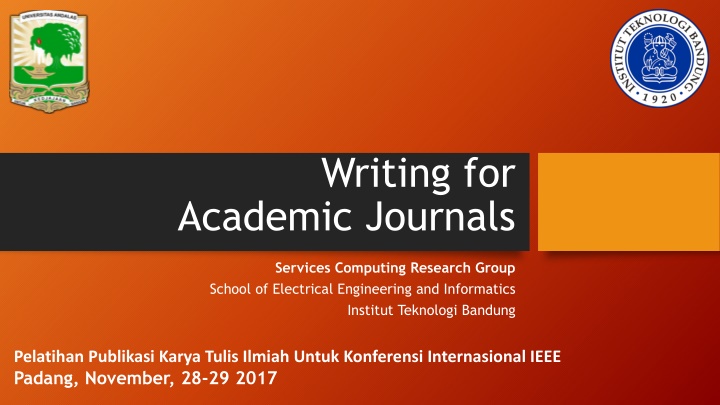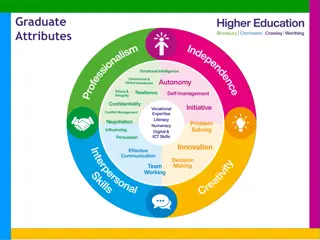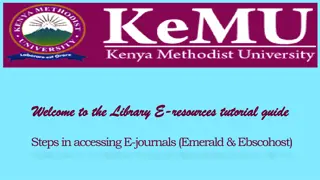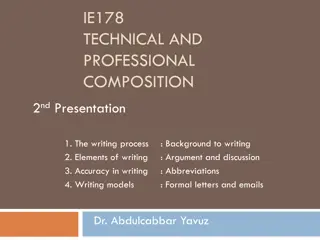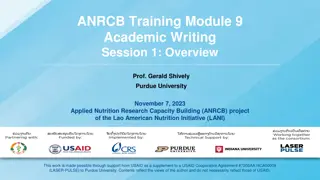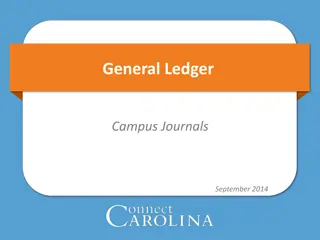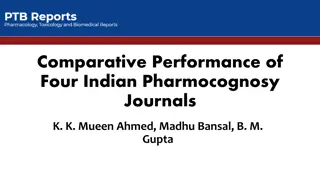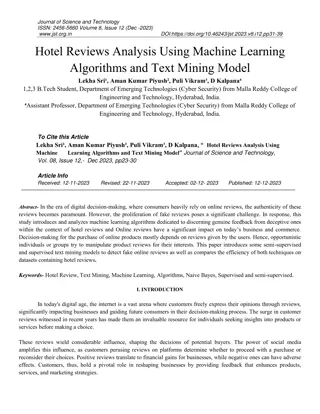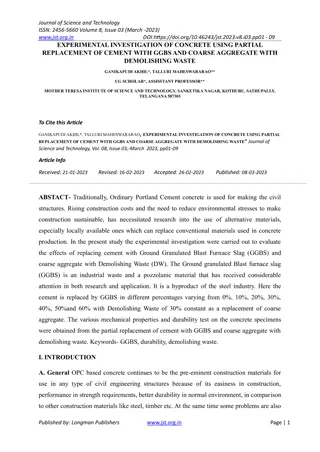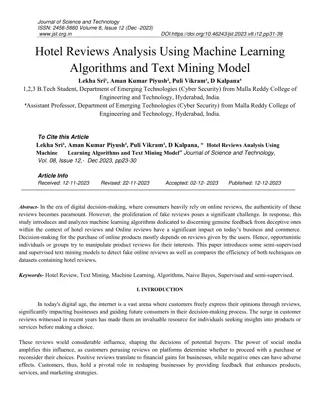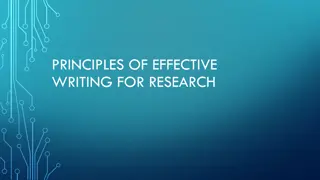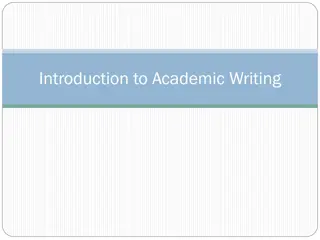Writing for Academic Journals: Essential Steps for Successful Research
Dive into the world of academic journals and learn the key steps to conducting research, structuring your articles, and understanding the format. Discover how to begin your writing journey, explore research backgrounds, delve into article formats, and initiate the writing process. Uncover the main sections of journal articles and grasp the significance of each component. Enhance your understanding of abstracts, introductions, methods, results, discussions, and references. Start your academic writing endeavor with confidence and knowledge.
Download Presentation

Please find below an Image/Link to download the presentation.
The content on the website is provided AS IS for your information and personal use only. It may not be sold, licensed, or shared on other websites without obtaining consent from the author.If you encounter any issues during the download, it is possible that the publisher has removed the file from their server.
You are allowed to download the files provided on this website for personal or commercial use, subject to the condition that they are used lawfully. All files are the property of their respective owners.
The content on the website is provided AS IS for your information and personal use only. It may not be sold, licensed, or shared on other websites without obtaining consent from the author.
E N D
Presentation Transcript
Writing for Academic Journals Services Computing Research Group School of Electrical Engineering and Informatics Institut Teknologi Bandung Pelatihan Publikasi Karya Tulis Ilmiah Untuk Konferensi Internasional IEEE Padang, November, 28-29 2017
Where Do I start? TOPIC What are you going to write about? A study you have completed? A Review of literature? I don t know
RESEARCH BACKGROUND Read articles on a topic you are interested in. Look in the reference or recommended readings section of textbooks to find a topic. When you find an article that includes information or a topic you want to work on find the articles in ITS reference section. Read them.
Article Format As you read articles for your BACKGROUND, pay attention to the format. What are the main sections of the article? What subtitles did the author use? How is the information each section different?
What is Article Format? Format is the basic design of the article. It is the blueprint for writing the article.
Review Why Read other journal articles FIRST? To find a specific research topic or question. RETEST AN EXPERIMENT FORM ANOTHER ARTICLE IN A NEW SITUATION. CREATE A NEW EXPERIMENT BY MODIFYING A PREVIOUS ONE. CONNECT YOUR OWN IDEAS TO WORK THAT HAS ALREADY BEEN PUBLISHED. To learn the journal format for the field/publication for your interests. To take notes for the Literature Review section of your article.
Now, Do the research. Then write the Article.
Main sections of Journal Articles 1. Abstract 2. Introduction 1. Concept 2. Research Problems -> Research Motivation 3. Methods and Materials 4. Results 5. Conclusions 6. Bibliography / References 7. Appendices (Appendix) definition theory method (construct theory)
1. Abstract @150 words (check specific instructions for length 120-200) Give a summary of what you did, how you did it, and what your results were Short, short, short don t include everything!
2. Introduction Description of the general context for your research Become more specific (inverted triangle model) Review of Literature Tell why you need to do this study? What motivated you to do it? What problem exists that you want to solve? State the research problem Give a hypothesis (if needed)
Review of Literature Include information from texts most closely related to your work These should help you describe your motivation Connect the individual works to each other and to your work Show how the information in the other articles present a problem that you want to solve or study. Work 1 Work 2 Work 3
Using Transitions in the Literature Review Clearly explain: Why are the texts mentioned important to your study? How does each text connect to the other texts in the literature review? Are any of the texts mentioned more important to your research than others? Say so, and explain why.
3. Methods and Materials Explain how you conducted your research BE EXPLICIT! Give information that is detailed enough that another person could do exactly the same procedures that you did in exactly the same way Many, many, many details What materials did you use? How did you collect data? Organize information by Chronological (Time) Order what did you do first? Then what? Development of the design Data Analysis
Possible information for methods section Instrumentation Data collection Sampling Experimental procedures (step by step) Materials used (include everything!) (Tell what size, how much, etc.) Statistical analyses used (DO NOT include the results of the analyses here only what you used e.g. name of computer program, type of analysis run)
4. Results and discussion Explain the results of the data analysis don t include calculations, only results Use tables or graphs to summarize information Discuss / Describe the results Why are the results important? What does the data tell us that we need to remember/know?
Using Tables Use specific, descriptive titles Give source of content Use row / column names Don t put too much data in one table Use a good format( spacing, number size, not crowded, easy to read) Use the same format for all tables in the article Put tables as close to the reference in the text as possible (top or bottom of same page or on the previous / following page) Limit to one page (longer tables should go in the appendices)
Discussion Tell why the results are important or significant 1. Talk about the hypothesis in relationship to the results (if you had a hypothesis) 2. Discuss the experimental design 3. Identify possible sources of errors 4. Give the results of other researchers (compare with your own results) 5. Describe the limitations of your study (what didn t your study do) 6. Suggest Further Research
5. Conclusions Restate the research problem Give a big picture view of the results DON T REPEAT WHAT YOU WROTE IN THE RESULTS OR DISCUSSION SECTIONS
Preparation to write a conclusion 1. List all of your results in order from least to most important. 2. Connect the results to the research problem and the larger context of the research. 1. How is each result significant in your field / project? 3. Think of any other possible ways to interpret your results and explain why those interpretations are wrong. 1. This shows your reader that you have considered other possible reasons for the results. It proves you are not Jumping to conclusions .
5A. ACKNOWLEDGEMENTS Thank the university or company that funded you Thank any person who aided in your research Thank anyone who helped you write the report
6. Bibliography / REferences Bibliography a list of all works consulted or read for the project, but not all of the works are cited in the text of the article. References (Works Cited) a list of the texts that are cited in the article.
Citations and Bibliographies Any time you use words or information that comes from a different written source, you must cite (name) who wrote it and where it was written (published) Different formats: apa, mla, university of Chicago Follow the same format as in other articles in the journal (or syllabus) Read instructions carefully (they will often tell you what format to use) Ask, don t guess
7. Appendices Use for larger material that does not fit well into the text of the article Long charts or tables Pictures (step by step procedural pictures) diagrams
Other Important Information Remember to keep your audience in mind Explanations, language, terminology used Outline each section of the article on paper before writing it This will help you remember to add transitions, keep your ideas organized, and help you to remember everything you need to include Limit Quotations (in number and length) Longer quotations used in qualitative research (humanities and social sciences), not quantitative (sciences) Follow limits on Length Word/page limits and minimums should be met Check if limits include bibliography and appendices
Publishing: Find a home for your article Research the different journals in your field of study Academicjournals.org Journalseek.net Sciencedirect.com What area of the field do they specialize in? Scan through one or two issues. Are the topics of the articles similar to your article s topic? Read the Journal s description . Does this description include information similar to what is in your journal article? Follow the Journal s Instructions for Authors
THANK YOU FOR YOUR TIME! ANY QUESTIONS? Services Computing Research Group School of Electrical Engineering and Informatics Institut Teknologi Bandung
